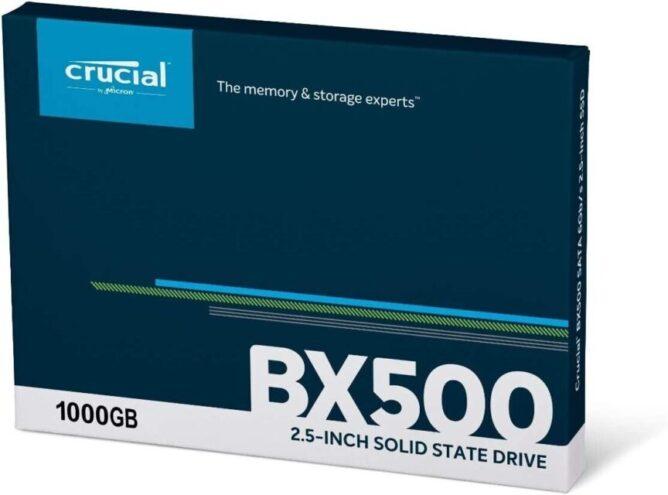Which has better read and write speed – PNY CS900 vs Crucial BX500 ? PNY CS900 has exceptional performance offering up to 515MB/s seq. Read and 490MB/s seq. Write speeds. Where as Crucial BX with Form Factor of 2.5-inch delivers Read Speed 540 Megabytes Per Second and Write Speed 500. They Load files quicker, improve overall system responsiveness and 300% faster than a typical hard drive. Reveal more in PNY CS900 vs Crucial BX500 comparison.

Crucial BX500 1TB SATA III 2.5″ Internal SSD
advertisement
PNY CS900 vs Crucial BX500 comparison
| PNY CS900 | Crucial BX500 | |
|---|---|---|
| Interface | SATA III (6 Gb/s) | SATA III (6 Gb/s) |
| Maximum Read Speed | 535 MB/s | |
| Maximum Write Speed | 500 MB/s | |
| Sequential Read Speed | 540 MB/s | |
| Sequential Write Speed | 500 MB/s | |
| Drive Type | SSD | SSD |
| Form Factor | 2.5″ (7 mm) | 2.5″ (7 mm) |
| Flash Memory Type | Tri-Level Cell (TLC) | |
| SMART Support | Yes | |
| TRIM Support | Yes | |
| Endurance (Total Bytes Written) | 80 TB | |
| Mean Time Between Failures (MTBF) | 1.5 Million Hours |
What are the differences and similarities – PNY CS900 vs Crucial BX500?
Common
First of all, both are SSDs with the 2.5-inch form factor. They have 7mm-thick enclosures, so they are compatible with most slim notebooks that are quite popular nowadays. They do have their own 9mm adapters in order to fit snugly in full-sizes systems.
Capacity
When it was first released, PNY CS900 only had three capacity options: 120GB, 240GB, and 480GB. However, the technology has advanced enough to make NAND chips significantly more affordable. As the effect, the company has managed to introduce a 960GB capacity option. All of the capacities come with very competitive prices.
This, of course, has increased the demand, too, so it is a good thing that Crucial BX500 comes with 120GB, 240GB, 480GB, and 960GB capacity options.
Compatibility
PNY CS900 is compatible with most platforms, including Windows and Mac, so it should be able to work without any complicated set-up or configuration.
Hardware
Crucial BX500? This SSD runs on an SMI SM2259XT four-channel controller. It utilizes 96 layers of 3D TLC NAND chips from Micron. The SSD is available in the 2.5-mm form factor with the 6Gbps SATA interface.
PNY CS900 is built with TLC NAND chips. Compared to MLC and SLC variants, the TLC NAND chips are cheaper to manufacture. It also enables the SSD to have a large capacity without expanding the physical size.
Application
Crucial BX500 does include two software applications. The first one is Acronis True Image HD for data migration and system backup. The second one is Crucial Storage Executive, which is for monitoring the SSD status, updating the firmware, and enabling or disabling the “momentum cache” feature. The company claims that this feature can increase the performance of the SSD up to 10x.
PNY CS900 vs Crucial BX500 Read & write speed comparison
The specs sheet of Crucial BX500 claims that the maximum sequential read and write speeds are 540MB/s and 500MB/s across all capacity options. However, when tested, there are minor differences between them, with the 960GB model being the closest to the claimed speeds.
When the 120GB model is tested, the sequential read and write speeds are 362MB/s and 247MB/s. These are actually lower than Crucial BX500 of the same capacity. However, the random read and write speeds are significantly higher at 27.9MB/s and 70.3MB/s. The random mixed IO speed is also better at around 26.2MB/s.
Performance review – PNY CS900 vs Crucial BX500 comparison
PNY CS900
PNY CS900 is slower than Crucial BX500 in sequential reads and writes, but much faster when dealing with random operations. The gap between the 480GB models is especially huge. PNY CS900 can reach 30.3MB/s on random mixed IO tasks, while Crucial BX500 is struggling in sub-20MB/s.
Interestingly, the 960GB model of PNY CS900 hasn’t been able to keep the lead. The overall performance is still good, and it is still a bit faster on random mixed IO tasks. However, the 960GB model of Crucial BX500 is able to beat it in sequential read, sequential write, random read, and random write with some convincing margins.
Crucial BX500
When tested, the 120GB model of Crucial BX500 can reach 468MB/s and 373MB/s in sequential read and write, respectively. However, the random read speed is very low at 27.5MB/s, and the random write speed is only around 42.8MB/s. In mixed random IO tasks, the average speed is really lagging around 15.3MB/s.
The same trend still applies to the 240GB and 480GB model. With the 240GB model, the average speed for mixed random IO is only around 15.6MB/s. With the 480GB model, there is some increase to 18MB/s, but this is still quite low.
Editor’s recommendations
- SanDisk 1TB ultra microSDXC UHS-I memory card with adapter review
- Kingston FURY Renegade 64GB (2x32GB) DDR4 3200 desktop memory review
- Lexar Hades 32GB DDR4-3600MHz review – does it support Xbox gaming?
- Gigabyte AORUS Gen4 7000s SSD 2TB PS5 review
- ADATA XPG GAMMIX S70 Blade 1TB PCIe Gen4x4 M.2 2280 SSD review
